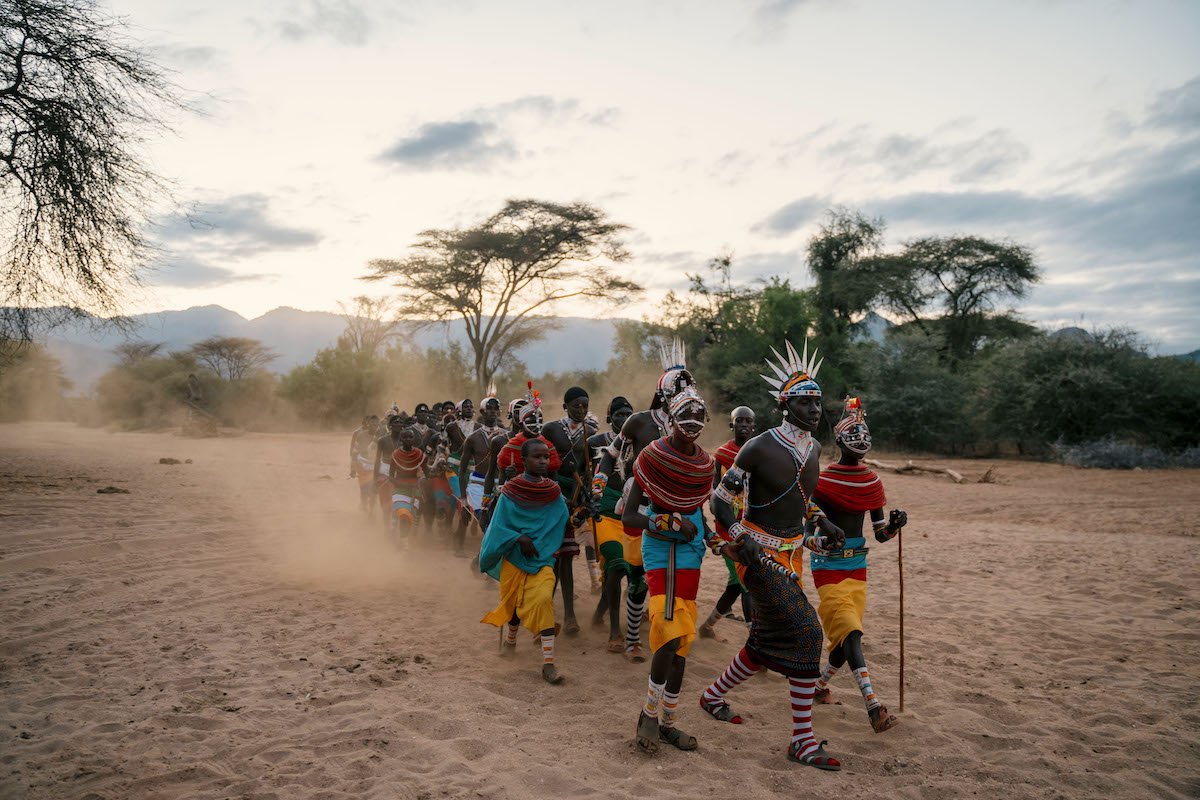
The Samburu
The heartbeat of Northern Kenya
Peaceful, pastoral, and deeply in touch with the natural world, the Samburu have been sustaining their age-old traditions over many centuries – and it’s one of the best-preserved cultures in Africa today.
Still living according to the customs they’ve inherited from their forefathers and learned at the feet of their parents and Elders – their lifestyle embodies a rich historical legacy.
Amid the sweeping changes of the modern world, the Samburu fiercely guard their ancestral traditions – standing as unwavering protectors of this rare and remotely set land. It’s a privilege to be welcomed into this age-old way of life and learn more about a beautifully preserved culture – one that should be deeply respected and admired.

SAMBURU WARRIORS

SAMBURU WOMEN WITH THEIR LIVESTOCK

SAMBURU MOTHER MILKING HER GOATS

SAMBURU MANYATTA

MANYATTA FROM ABOVE

SAMBURU BEADWORK

SAMBURU DANCING
Origins and Language
The Samburu are Nilo-Hamitic (a group of East African pastoral peoples) and related to the Laikipiak Maasai. It is believed that they originated from Southern Sudan, just like other Nilotic groups in Kenya, before settling south of Lake Turkana in the Rift Valley and north of Mount Kenya. Arriving in the 15th century, they parted ways with the Maasai, who moved further south while they moved north. In the mid-19th century, the Samburu controlled a very large tract of land stretching from Lake Turkana to Ethiopia. Clashes with the Turkana and Purko however forced them to retreat south to their present-day range. Samburu is a dialect of the Maa language, which is spoken by the Masaai.
Livestock
Being semi-nomadic, livestock plays a vital role in everyday Samburu life. They mainly depend on drought- and disease-resistant breeds, and apart from livestock being a prominent indication of a family’s wealth, it’s also the main form of exchange and food during social occasions – such as marriage, circumcision, and cultural exchanges.
Home Life
The local diet comprises mostly of milk and occasionally blood from cows. As the region is semi-arid, it’s necessary to keep moving from place to place to find sufficient water and food for all, so the Samburu change location often to find fresh grazing grounds. Homesteads (“manyattas”) consist of huts constructed from hide, mud, and grass mats strung over poles, and fences built around the mud huts for protection from wild animals. Men are traditionally responsible for taking care of both the livestock and everyone’s overall safety. While being very adept with digital technology and social media, the Samburu still retain most of their age-old traditions and live largely unaffected by modern civilisation.
Music and Dance
Integral to indigenous culture, these powerful forms of expression are not only steeped in history, but also a prominent part of community life. Passed down from generation to generation, the Samburu’s unique musical traditions provide a profound sense of identity and belonging. Characterised by distinctive rhythms and energetic movements that tell vivid stories about this region’s history – they’re used to convey emotions, celebrate important occasions, and pass on knowledge.
Age Sets
In Samburu, age isn’t measured in years, but rather in four ‘age sets’. Youth become warriors (“morans”), warriors become Junior Elders, and Junior Elders become Elders. The age sets promote a sense of camaraderie, community, and unity – qualities that have enabled the Samburu to prosper for centuries. Every seventh year, a ceremony called “Lmuget” marks the passage from boy to warrior – a much-anticipated event that sees hundreds of warriors and families gather to celebrate this deeply traditional moment in time. Typically aged 14-25, morans are highly respected in the community and play a central role in many ceremonies and rituals.
Hierarchy
Functioning as a gerontocracy, the Samburu’s social structure is incredibly unique. It entails being governed strictly by the Elders – who make all decisions. They not only have the final say in all matters, but also possess the power to curse younger members of the community. The Elders are deeply revered, and their wisdom and insight are integral to the community’s unity and strength.
Decorative Clothing
Renowned for their colourful clothing, the so-called Butterfly People clothing and beadwork hold significant cultural and spiritual meanings too. Resembling the patterns on butterfly wings, brightly beaded garments and decorative items express everything from social rank and status to age – and are worn by both women and men. Morans wear their hair in long braids, while women, keep their heads shorn. You can also distinguish a male Samburu’s age set, social status, and special responsibilities from the appearance of his spear.
Religious Life
The Samburu are very religious, with the ultimate source of power attributed to their God, N’gai. The Elders, who are responsible for law and order, are devout and follow N’gai’s guidance throughout. It is believed that N’gai is the source of all protection from the dangers of existence.
Storytelling
Often using metaphors, idioms, symbols, and proverbs to illuminate topics and conversations, the Samburu are storytellers at hearts. With oral narrative as an integral part of life, vivid accounts of the past allow the history of Samburu to stand the test of time. Every age set also has particular songs that tell their stories – and offer a window into their experiences and outlook on the world.
